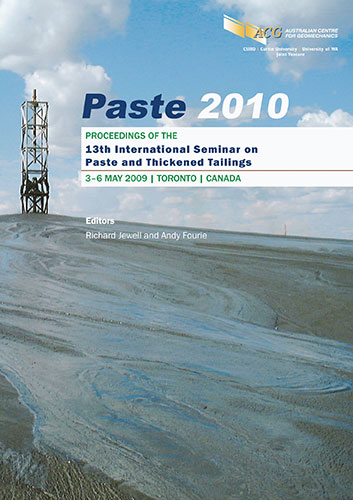Potential environmental benefits of surface paste disposal

|
Authors: Verburg, R Paper is not available for download Contact Us |
DOI https://doi.org/10.36487/ACG_rep/1063_20_Verburg
Cite As:
Verburg, R 2010, 'Potential environmental benefits of surface paste disposal', in R Jewell & AB Fourie (eds), Paste 2010: Proceedings of the Thirteenth International Seminar on Paste and Thickened Tailings, Australian Centre for Geomechanics, Perth, pp. 231-240, https://doi.org/10.36487/ACG_rep/1063_20_Verburg
Abstract:
In most countries in the world today, disposal of tailings in traditional form (i.e. as a slurry) has come under increasing scrutiny due to the perceived risks associated with environmental impacts and dam safety. Pressures for change come from the many stakeholders that are involved with the development and operation of a mine, including decision-makers in the mining company, shareholders, auditors and reviewers, lending agencies and financial institutions, insurers, regulators, the local communities, and NGOs. These pressures are forcing the mining industry to seek innovative alternatives for disposal of tailings that will incorporate less risk and address the rising environmental and social concerns. The current trends are to reduce or even eliminate ponded water on top of tailings and to thicken tailings to facilitate alternative disposal configurations. Paste tailings have many potential environmental, economic and social benefits. This paper presents and discusses potential environmental benefits of surface paste disposal, such as the reduction in seepage volumes and contaminant migration. Also, this paper will address the potential advantages of paste with respect to increased chemical stability, including prevention of sulphide oxidation and acid generation. These benefits will be illustrated using case histories, in particular the ongoing studies in paste behaviour at Somincor’s Neves Corvo Mine in southern Portugal. The case studies demonstrate that disposal of high-pyrite tailings in the form of paste represents a feasible option, with proper cover design being a critical component of the placement and closure strategy.
References:
ASTM (2000) Designation: D 5744-96, Standard Test Method for Accelerated Weathering of Solid Materials Using a
Modified Humidity Cell.
Elberling, B. and Nicholson, R.V. (1996) Field determination of sulphide oxidation rates in mine tailings, Water
Resources Research, 32(6), pp. 1773–1784.
Junqueira, F., Wilson, G.W. and Oliveira, M. (2009) Surface Paste Disposal of High-Sulphide Tailings at the Neves
Corvo Mine in Portugal, Part 1: Estimation of Tailings Desaturation and Implications on ARD Generation,
Proceedings of the Eighth International Conference on Acid Rock Drainage, Skellefteå, Sweden, June 22–26,
2009.
SoilVision Ltd (2007) SVOffice finite element package, www.soilvision.com.
Verburg, R.B. (2002) Paste Technology for Disposal of Acid-Generating Tailings, Mining Environmental Management
10(4), pp. 14–18.
Verburg, R., Johnson, B., Fordham, M. and Logsdon, M. (2003) A Rapid and Cost-Effective Method for Bench
Screening of Geochemical Performance and Disposal Options for High-Sulphide Tailings, in Proceedings Sixth
International Conference on Acid Rock Drainage, Cairns, Queensland, July 12–18, 2003.
Verburg, R., Newman, P. and Fordham, M. (2006) Surface Paste Disposal of High-Sulfide Tailings – Field Cell
Monitoring and Pilot Plant Testing, in Proceedings Seventh International Conference on Acid Rock Drainage, St.
Louis, Missouri, March 26–29, 2006.
Verburg, R., Ross, C. and Oliveira, M. (2009) Surface Paste Disposal of High-Sulphide Tailings at the Neves Corvo
Mine in Portugal, Part 2: Field Trials, Cover Performance Monitoring, and Impact Assessment, in Proceedings
Eighth International Conference on Acid Rock Drainage, Skellefteå, Sweden, June 22–26, 2009.
© Copyright 2025, Australian Centre for Geomechanics (ACG), The University of Western Australia. All rights reserved.
View copyright/legal information
Please direct any queries or error reports to repository-acg@uwa.edu.au
View copyright/legal information
Please direct any queries or error reports to repository-acg@uwa.edu.au